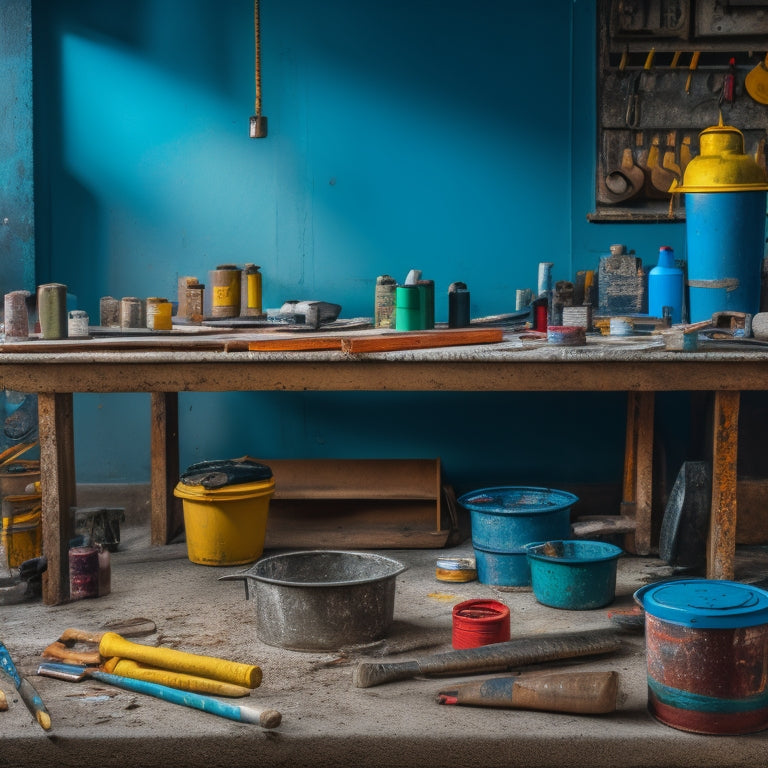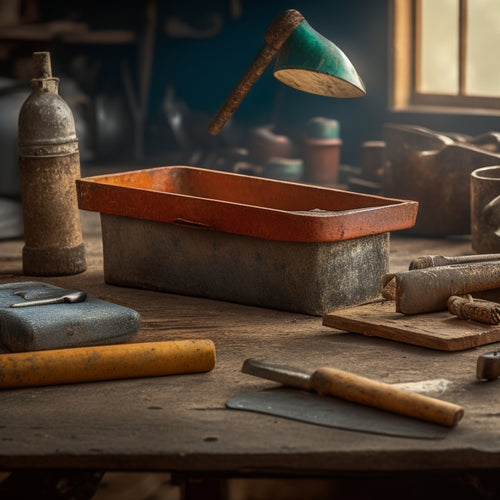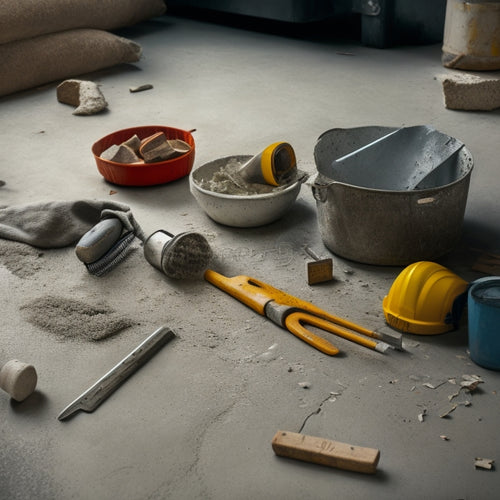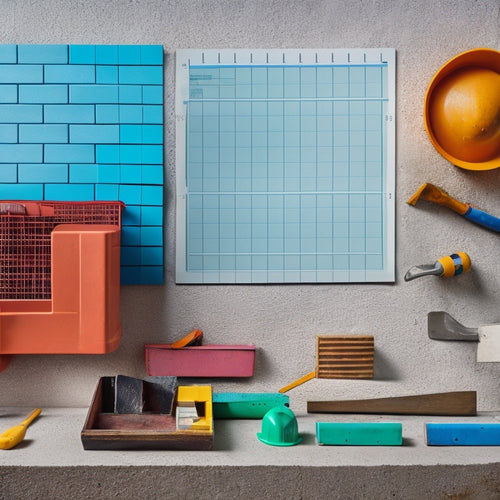
Essential Tools for Painting Concrete Walls
Share
When painting concrete walls, you'll need a range of specialized tools to achieve a professional-looking finish. Start by preparing the surface with cleaning and assessment tools, then prime the wall for a strong paint bond. Choose the right paint for the job, considering factors like environmental considerations and ambiance. Essential painting tools include natural or synthetic brushes, rollers, and extension poles. Don't forget protective gear like safety goggles and knee pads, as well as cleaning and maintenance tools like pressure washers and scrub brushes. With the right tools, you'll be well on your way to a beautifully painted concrete wall, and there's more to uncover to guarantee a flawless finish.
Key Takeaways
- Surface preparation is crucial, involving cleaning, assessing cracks and holes, and priming the concrete wall for a strong paint bond.
- Choose the right paint for concrete walls, considering acrylic latex or epoxy-based paints, color, ambiance, and environmental factors.
- Invest in essential painting tools, including natural and synthetic brushes, rollers, extension poles, and protective gear like safety goggles and knee pads.
- Cleaning and maintenance tools, such as pressure washers, scrub brushes, and sealers, are necessary for surface preparation and ongoing care.
- Specialized tools like texture guns, stencils, texture mats, and stamping tools can help create unique textures and finishes on concrete walls.
Preparing the Concrete Surface
Get ready to tackle the concrete surface by clearing the area of any debris, old adhesives, or previous coatings that may interfere with the new paint job.
You'll need to perform thorough surface cleaning to remove dirt, grime, and oils that can affect paint adhesion. Next, assess the surface for cracks and holes, and apply patching techniques to repair them.
Don't forget to conduct moisture testing to identify any areas with high moisture levels, as this can impact paint performance.
Once the surface is clean and repaired, it's time for surface priming. This step helps create a strong bond between the concrete and the paint. If you notice any cracks, use crack filling compounds to fill them in.
Finally, conduct a texture assessment to determine if the surface requires additional preparation, such as sanding or etching, to achieve the desired finish.
Choosing the Right Paint
You'll need to select a paint that's specifically designed for concrete walls, as they require unique properties to adhere well and withstand the surface's alkalinity.
You'll have two primary options: acrylic latex or epoxy-based paints, each with its own strengths and weaknesses.
When choosing a color, consider the ambiance you want to create, as well as the surrounding decor, to guarantee a harmonious result.
Paint Type Options
When preparing to paint concrete walls, selecting the right paint type is crucial, as it directly affects the final result's durability and appearance.
You'll want to take into account factors like environmental considerations, sheen levels, and paint durability to guarantee the best outcome.
Here are some paint type options to take into account:
-
Acrylic paints: A popular choice for interior paints, acrylics are water-based, easy to clean up, and dry quickly. They're suitable for most interior concrete walls, offering a low-sheen finish.
-
Epoxy coatings: Ideal for high-traffic areas or outdoor finishes, epoxy coatings provide exceptional durability and resistance to chemicals and abrasion. They're available in various sheen levels, from matte to high-gloss.
-
Masonry primers: Designed specifically for concrete, masonry primers help create a strong bond between the paint and the wall. They're crucial for guaranteeing a long-lasting, durable finish.
- Specialized coatings: Depending on your specific needs, you may want to take into account specialized coatings, such as those with added UV protection or rust-inhibiting properties.
These coatings can provide extra protection for your concrete walls in harsh environments.
Color Selection Guide
Color Selection Guide (Choosing the Right Paint)
With numerous paint color options available, selecting the perfect hue for your concrete walls can be a challenging task. You'll want to contemplate how the color will affect the ambiance of the space and the mood of its occupants. This is where color psychology comes into play. For example, cool tones like blues and greens can create a calming atmosphere, while warm tones like oranges and reds can stimulate energy.
When choosing a color, you'll also want to contemplate trending palettes that complement your concrete walls. Neutral shades like beige, gray, and taupe are popular choices as they provide a clean backdrop for decorative elements.
If you want to add some personality to your space, contemplate bold, bright colors that can add visual interest. Ultimately, the right color will depend on your personal preferences, the intended use of the space, and the style you're aiming to achieve.
Take your time, and don't be afraid to test out samples before committing to a specific shade.
Essential Painting Brushes
Selecting the right brushes for painting concrete walls is an essential step in achieving a professional-looking finish. You'll need to choose brushes that can handle the rough texture of concrete and apply paint smoothly.
When it comes to brush types, you have several options:
-
Natural bristle brushes: Ideal for oil-based paints, these brushes absorb and hold a lot of paint, making them perfect for covering large areas.
-
Synthetic brushes: Better suited for water-based paints, these brushes are more durable and resistant to wear and tear.
-
Angled-cut brushes: Great for cutting in around edges and corners, these brushes allow for precise control and smooth application.
- Stiff-bristle brushes: Useful for applying texture and creating pattern effects, these brushes are perfect for adding visual interest to your concrete walls.
Mastering various brush techniques will also help you achieve a flawless finish. Practice different strokes, such as sweeping, dragging, and dabbing, to get the desired effect.
Remember to always choose the right brush for the job and use it correctly to guarantee a professional-looking finish.
Rollers and Extension Poles
Precision is key when it comes to painting concrete walls, and the right rollers and extension poles can make all the difference in achieving a smooth, even finish. When selecting a roller, you'll need to take into account the type of paint you're using, the surface texture of the wall, and the desired finish. There are three main types of rollers: microfiber, wool, and foam. Microfiber rollers are ideal for smooth surfaces and water-based paints, while wool rollers are better suited for textured surfaces and oil-based paints. Foam rollers are perfect for creating a textured, rustic finish.
| Roller Type | Paint Type | Surface Texture |
|---|---|---|
| Microfiber | Water-based | Smooth |
| Wool | Oil-based | Textured |
| Foam | Water-based | Textured |
When it comes to extension poles, look for features such as adjustable length, non-slip grips, and durable construction. A good extension pole should allow you to reach high areas with ease and provide a comfortable grip to reduce fatigue. With the right roller and extension pole combination, you'll be able to achieve a professional-looking finish with ease.
Protective Gear and Accessories
You've got your roller and extension pole in hand, now it's time to think about your own safety and comfort on the job.
Painting concrete walls can be a physically demanding task, and it's vital to prioritize your well-being to avoid injuries and guarantee a high-quality finish.
To meet safety standards, make certain you have the following essential protective gear and accessories:
-
Safety goggles: Protect your eyes from paint splatters and debris with sturdy, ANSI-approved goggles.
-
Dust mask: Prevent inhaling concrete dust and paint fumes with a reliable, NIOSH-approved mask.
-
Knee pads: Reduce fatigue and discomfort with heavy-duty knee pads designed for rugged surfaces.
- Gear storage: Keep your tools and accessories organized and within reach with a portable storage container or bucket.
Cleaning and Maintenance Tools
Concrete walls often harbor dirt, grime, and old coatings that can compromise paint adhesion and finish quality. To guarantee a strong bond between the paint and the concrete, you'll need to clean the surface thoroughly.
Invest in a pressure washer and a surface cleaner to blast away dirt and grime. A scrub brush will come in handy for tackling stubborn stains and rough surfaces. Mix a cleaning solution according to the manufacturer's instructions and apply it to the wall using the scrub brush. Let it sit for the recommended time before rinsing off with clean water.
After cleaning, establish a maintenance schedule to keep your concrete walls looking their best. Apply a protective sealer to shield the surface from the elements.
Regularly inspect the walls for mildew and remove it immediately using a mildew remover. If you need to remove old adhesives, use an adhesive remover to prevent it from interfering with paint adhesion.
Specialized Tools for Textures
Achieving a uniform texture on concrete walls can be a challenge, but with the right tools, you can guarantee a professional-looking finish.
To master various texture techniques and pattern application, you'll need specialized tools that cater to specific texture requirements.
-
Texture guns: These tools dispense a mixture of cement, sand, and water to create a textured finish. They come in different nozzle sizes and types, allowing you to achieve various texture patterns.
-
Stencils: Use stencils to create intricate designs or patterns on your concrete walls. They're available in various materials, such as plastic or metal, and can be reused multiple times.
-
Texture mats: These mats feature raised patterns that you can press into wet concrete to create a textured finish. They're ideal for creating uniform textures over large areas.
- Stamping tools: Stamping tools feature interchangeable patterns that you can press into wet concrete to create realistic stone or brick patterns.
Frequently Asked Questions
Can I Paint Over Existing Concrete Wall Paint Without Prep Work?
You can't guarantee ideal paint adhesion without proper surface preparation, as existing paint may be flaking or chalky, hindering new paint's bond; scrape off old paint, clean, and etch the surface for a strong, durable finish.
How Do I Achieve a Smooth Finish on a Rough Concrete Wall?
Like a skilled sculptor, you'll need to tame the rough beast of concrete to achieve a silky smooth finish; use power sanding and grinding to devour imperfections, then apply surface primers and employ expert smoothing techniques to bring out the wall's hidden beauty.
What Is the Ideal Temperature for Painting Concrete Walls?
When you're painting concrete walls, you'll achieve ideal results by doing so in the best weather conditions, typically between 50°F to 90°F (10°C to 32°C), with humidity levels between 40% to 60%, ensuring a smooth, even finish.
Can I Use Regular House Paint on Concrete Walls?
As you dip your brush into the can, remember that regular house paint won't cut it on concrete walls. You'll need specialized paint and proper concrete wall preparation, along with expert paint adhesion techniques, to guarantee a durable, long-lasting finish.
How Long Does It Take for Concrete Wall Paint to Fully Dry?
When you're painting concrete walls, you're likely wondering how long it takes for the paint to fully dry. The drying time typically ranges from 1-2 hours, but the curing process can take up to 30 days, depending on environmental conditions.
Conclusion
Finish your concrete canvas with finesse! Flawless finishes rely on the right tools. From preparing the surface to adding textures, you've got the essential arsenal. Now, grab your gear and get ready to render radiant results. Remember, precision painting requires premium products and practiced patience. Perfect your process, and your concrete walls will proudly proclaim their pampered perfection.
Related Posts
-

Smart Guide to Buying Used Concrete Hand Tools
You're about to buy used concrete hand tools, and you need to get it right. Dedicate time to identify the tools you n...
-

Top 10 Concrete Repair Tools for Small Fixes
You'll need the right tools to tackle small concrete repairs efficiently and effectively. When it comes to small fixe...
-

Reinforcement Tools Checklist for Concrete Block Walls
You'll need a range of reinforcement materials, including horizontal and vertical rebar, fiber mesh, and anchor bolts...


